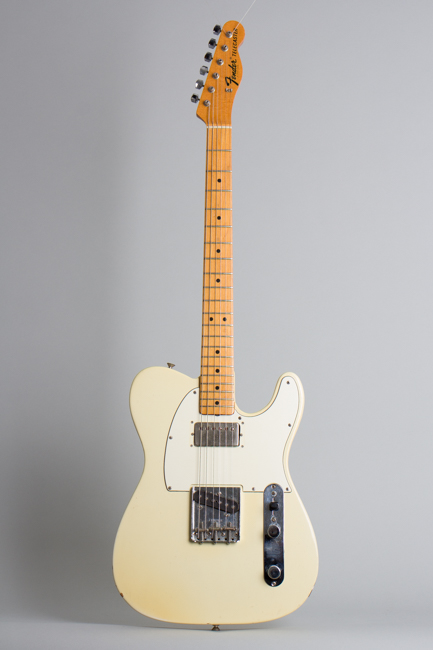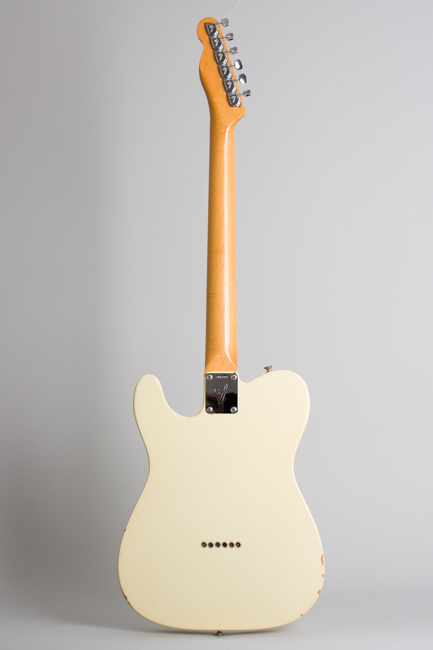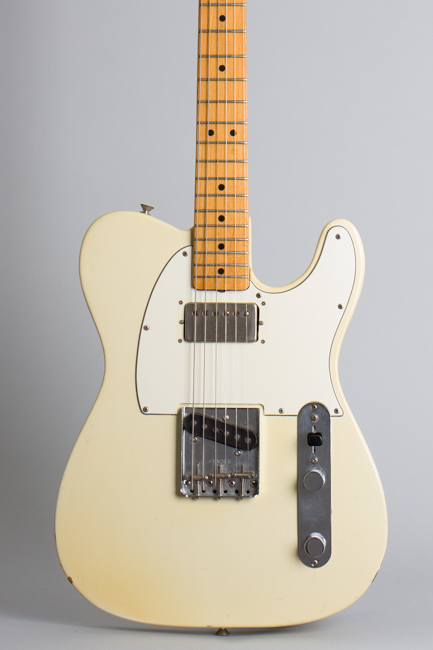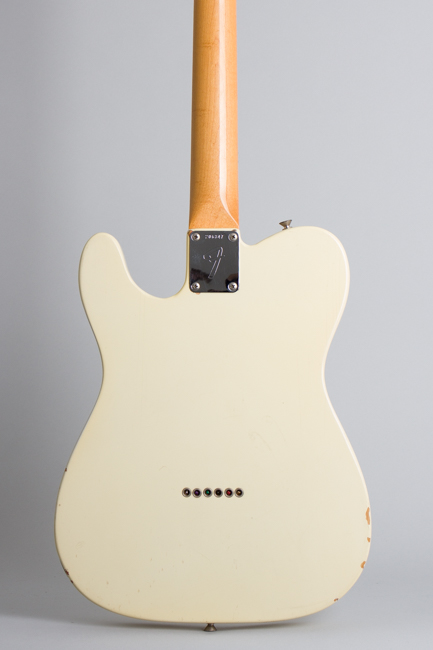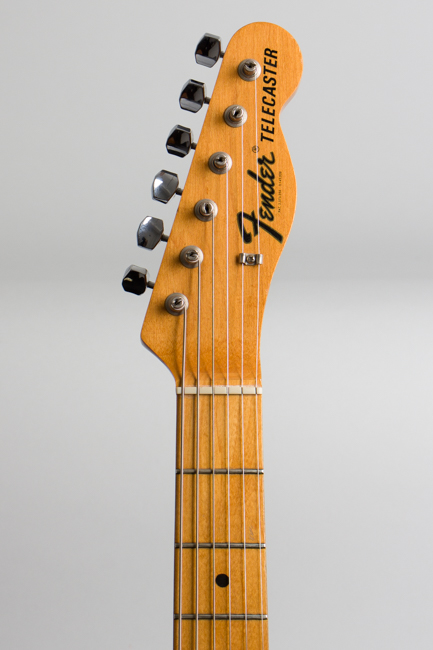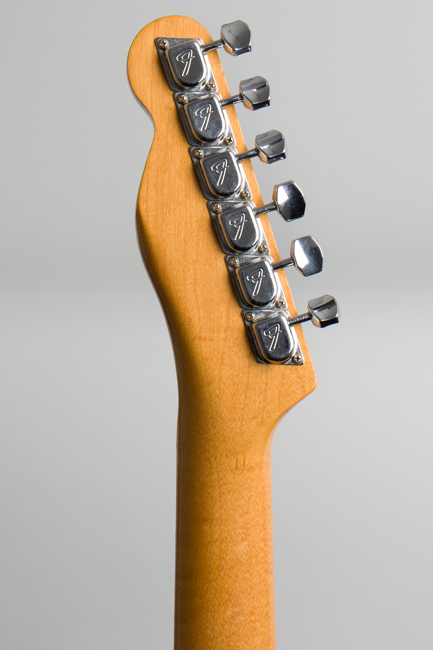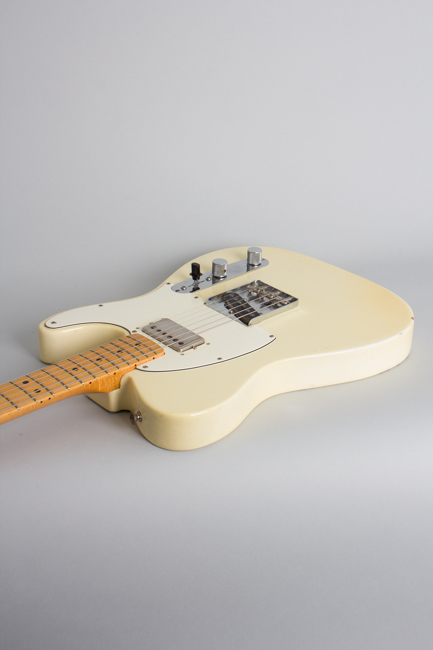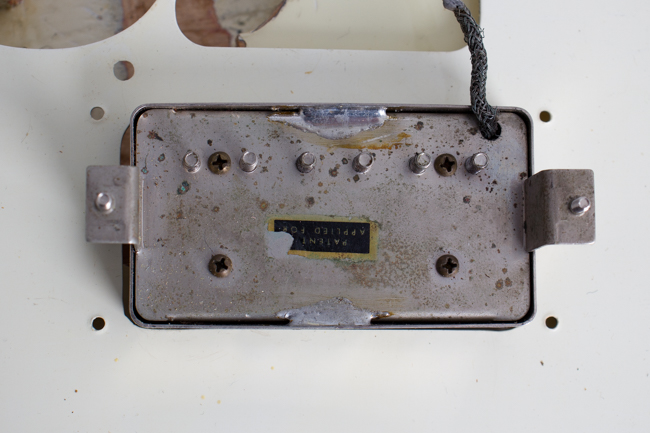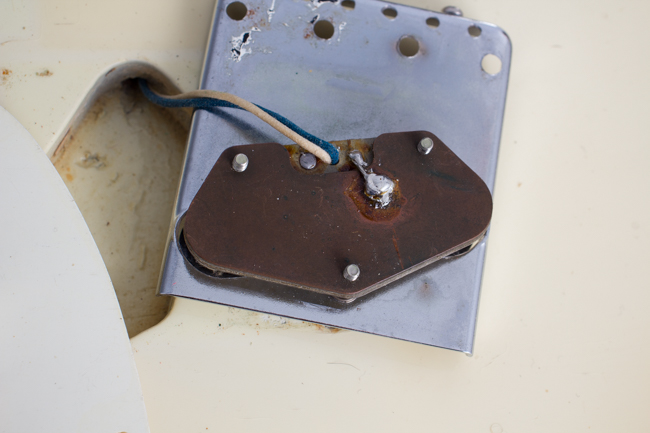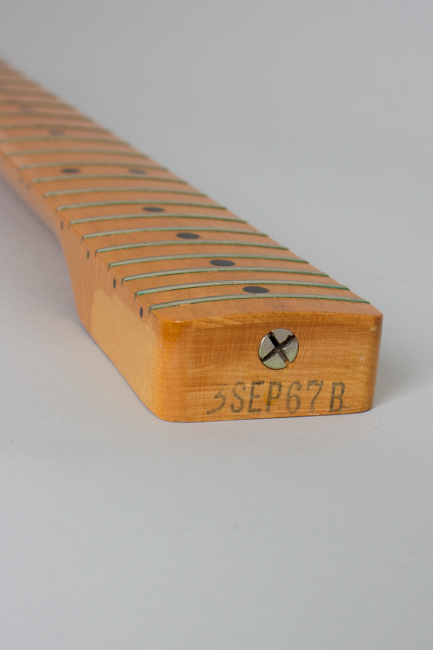Fender Telecaster Solid Body Electric Guitar (1967)
This item has been sold.
Item # 11186
Prices subject to change without notice.
Fender Telecaster Model Solid Body Electric Guitar (1967), made in Fullerton, California, serial # 206347, Blonde re- finish, ash body, maple neck with maple fingerboard, gig bag case.
This is a "classically modified" Fender Telecaster originally built in late 1967, showing one of the most common alterations players used to employ, a humbucking pickup substituted in the neck position. In this case, the pickup used is a genuine original Gibson PAF, adding substantial value to the package and a splendid sound besides! This pickup has never had the cover removed, and retains the original braided shielding on the lead, which has traces of the old Gibson grounding connection still soldered on. The wires were spliced before meeting the switch; as far as we can tell this super sought after pickup is completely original and unaltered.
The pickup modification over the decades gives it a sort of classic late 60s -70s appearance and character. The body was refinished in a close-to-original white/blonde decades ago, actually before the pickup rout was added as there is no finish in this area. The look is quite authentic if not exact, and there is some subsequent wear.
Except for the neck pickup and some wiring components the guitar retains its original hardware; the pots and tone capacitor have been replaced fairly recently, but the switch remains original. The pickguard is 3-ply white plastic, cut out as required for the larger Humbucking pickup. The original grey-bobbin Fender bridge pickup is intact dated 9-67 on the base; The shielding plate underneath it has been possibly replaced or at least re-soldered as the joint is somewhat sloppy.
Apart from these modifications the guitar shows features particular to that early-CBS era. The maple neck is still completely original and unaltered including finish, frets and tuners and dated on the heel to September 1967. This neck has the separate "laid-on" maple fingerboard characteristic of the period as the original 1950s style one piece neck had yet to be re-introduced after being discontinued in 1959. It also pre-dated the introduction of clear Polyester finished so still has the old thinner lacquer look and feel. The Fender headstock logo is in the newer large-letter style just introduced in 1967, for better visibility on TV according to CBS theory. The tuners are the Fender "F" logo style that replaced the earlier Klusons,
At 7.29 lbs. this guitar is lighter than many late 1960s and '70s examples and handles very well. Even as Fender was slipping into that "true-CBS" period it still retains the classic period character. Now while we almost certainly wouldn't rout one of these out today (even for a PAF!) this modded Tele is a sort of classic in its own right, an example of the layout many top session and working players preferred for their guitars before such combinations were available from the factory. While this is not a fully original guitar, it is a great playing and sounding one and a super cool piece of history.
Overall length is 38 3/4 in. (98.4 cm.), 12 5/8 in. (32.1 cm.) wide at lower bout, and 1 3/4 in. (4.4 cm.) in depth, measured at side of rim. Scale length is 25 1/2 in. (648 mm.). Width of nut is 1 5/8 in. (41 mm.)., 7.29 lbs.
As noted this Tele has had some obvious modification but is a excellent player's instrument. The white/blonde body finish is not original but looks and feels old and shows light general wear, mostly dings and chips along the edges as is typical with slab-sided Telecasters. It is somewhat thicker than a '67 era finish, more in line with the later '60s and 70s style. Some areas show a black undercoat, for reasons lost to history. The maple neck was not altered and retains the original thin lacquer finish which is really quite clean with checking mostly on the headstock and some small dings and dents.
Mounting the PAF obviously entailed routing to enlarge the cavity, which has not been finished over. Oddly enough this was done after the refinish work! The bridge pickup remains original, the correct grey-bobbin 1967 unit. The pickguard is the correct 3-ply white style routed for the larger pickup. At one point the PAF had a redundant mounting ring; this is gone but four small screws line the perimeter where it once sat, and the guard has a very subtle discoloration there as well. The PAF itself has some light corrosion to the metal, mostly to the polepieces.
The other hardware including the threaded-saddle bridge unit, F-logo tuners, switch, knobs and strap buttons remain original and quite clean. As noted the pots and cap are of more recent origin. Overall this is an excellent playing and sounding "studio" Telecaster. The original small frets and fingerboard show only light wear; it appears although modified to player preference this guitar was subsequently not used as much as many such Teles were. Both pickups sound great (and very different from each other) giving a wide range of tones. The genuine PAF adds substantial value to this instrument; it could be dismounted and re-purposed but we'd sort of hate to see that. We don't know the history behind this one, but it is a cool period piece with a killer sound and serious vibe. Overall Very Good + Condition.
This is a "classically modified" Fender Telecaster originally built in late 1967, showing one of the most common alterations players used to employ, a humbucking pickup substituted in the neck position. In this case, the pickup used is a genuine original Gibson PAF, adding substantial value to the package and a splendid sound besides! This pickup has never had the cover removed, and retains the original braided shielding on the lead, which has traces of the old Gibson grounding connection still soldered on. The wires were spliced before meeting the switch; as far as we can tell this super sought after pickup is completely original and unaltered.
The pickup modification over the decades gives it a sort of classic late 60s -70s appearance and character. The body was refinished in a close-to-original white/blonde decades ago, actually before the pickup rout was added as there is no finish in this area. The look is quite authentic if not exact, and there is some subsequent wear.
Except for the neck pickup and some wiring components the guitar retains its original hardware; the pots and tone capacitor have been replaced fairly recently, but the switch remains original. The pickguard is 3-ply white plastic, cut out as required for the larger Humbucking pickup. The original grey-bobbin Fender bridge pickup is intact dated 9-67 on the base; The shielding plate underneath it has been possibly replaced or at least re-soldered as the joint is somewhat sloppy.
Apart from these modifications the guitar shows features particular to that early-CBS era. The maple neck is still completely original and unaltered including finish, frets and tuners and dated on the heel to September 1967. This neck has the separate "laid-on" maple fingerboard characteristic of the period as the original 1950s style one piece neck had yet to be re-introduced after being discontinued in 1959. It also pre-dated the introduction of clear Polyester finished so still has the old thinner lacquer look and feel. The Fender headstock logo is in the newer large-letter style just introduced in 1967, for better visibility on TV according to CBS theory. The tuners are the Fender "F" logo style that replaced the earlier Klusons,
At 7.29 lbs. this guitar is lighter than many late 1960s and '70s examples and handles very well. Even as Fender was slipping into that "true-CBS" period it still retains the classic period character. Now while we almost certainly wouldn't rout one of these out today (even for a PAF!) this modded Tele is a sort of classic in its own right, an example of the layout many top session and working players preferred for their guitars before such combinations were available from the factory. While this is not a fully original guitar, it is a great playing and sounding one and a super cool piece of history.
Overall length is 38 3/4 in. (98.4 cm.), 12 5/8 in. (32.1 cm.) wide at lower bout, and 1 3/4 in. (4.4 cm.) in depth, measured at side of rim. Scale length is 25 1/2 in. (648 mm.). Width of nut is 1 5/8 in. (41 mm.)., 7.29 lbs.
As noted this Tele has had some obvious modification but is a excellent player's instrument. The white/blonde body finish is not original but looks and feels old and shows light general wear, mostly dings and chips along the edges as is typical with slab-sided Telecasters. It is somewhat thicker than a '67 era finish, more in line with the later '60s and 70s style. Some areas show a black undercoat, for reasons lost to history. The maple neck was not altered and retains the original thin lacquer finish which is really quite clean with checking mostly on the headstock and some small dings and dents.
Mounting the PAF obviously entailed routing to enlarge the cavity, which has not been finished over. Oddly enough this was done after the refinish work! The bridge pickup remains original, the correct grey-bobbin 1967 unit. The pickguard is the correct 3-ply white style routed for the larger pickup. At one point the PAF had a redundant mounting ring; this is gone but four small screws line the perimeter where it once sat, and the guard has a very subtle discoloration there as well. The PAF itself has some light corrosion to the metal, mostly to the polepieces.
The other hardware including the threaded-saddle bridge unit, F-logo tuners, switch, knobs and strap buttons remain original and quite clean. As noted the pots and cap are of more recent origin. Overall this is an excellent playing and sounding "studio" Telecaster. The original small frets and fingerboard show only light wear; it appears although modified to player preference this guitar was subsequently not used as much as many such Teles were. Both pickups sound great (and very different from each other) giving a wide range of tones. The genuine PAF adds substantial value to this instrument; it could be dismounted and re-purposed but we'd sort of hate to see that. We don't know the history behind this one, but it is a cool period piece with a killer sound and serious vibe. Overall Very Good + Condition.
